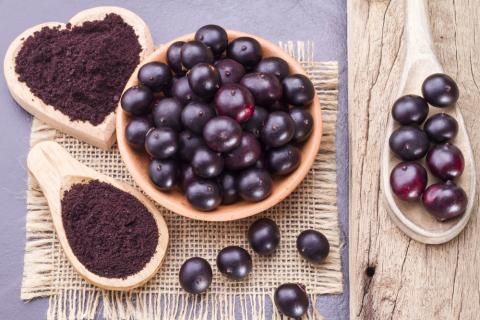
Acai berries are a member of the family Arecaceae or Palm family of the genus Euterpe Mart., commonly known as palm P, containing the species Euterpe oleracea Mart. or Assai palm P. The plant is native to the Amazon jungle and the people of the area have used the berries for medicinal purposes for millennia. However, the fruit was not introduced to most regions of the world until the late 20th century because they have a high fat content which makes them fragile to transport—they must be processed by freeze-drying, juice extraction, or spray drying to prepare them for shipping. They can be purchased in the United States in dry form, frozen, in capsules, or in juice, but the only way to eat fresh berries is to visit the Amazon jungle. Because of its high nutrient content acai is used to prevent many maladies and other health-related disorders. The correct pronunciation of acai is “ah-sigh-ee.”
What does acai look like?
The acai palm grows with four to eight slender trunks that measure about eight inches in diameter. The palm matures to a height of approximately eighty-two feet and each trunk is crowned with nine to fifteen compound leaves that measure four-to-thirteen feet long.They produce brown-purple blooms that hang from the tops of the stems from which the acai berries are produced.
The fruit is a drupe that matures to approximately six inches in diameter and contains one large seed with a deep purple hue. The stem produces about eight clusters of berries that weigh up to thirteen pounds each.
Health Benefits Of Acai
Acai berries are rich in nutrients, containing vitamins B1 (Thiamin), B2 (Riboflavin), B3 (Niacin), C, and E (tocopherol). Also present in the fruit are minerals that include iron, potassium, phosphorus, and calcium. Other beneficial substances found in acai berries are fiber, proteins, lipids, and essential fatty acids.
Acai berries are excellent in keeping the skin healthy due to the presence of antioxidants which prevent many skin disorders, slow down the aging process, and improve metabolic function. The fiber found in the berry aids in cleansing the body and maintains a healthy digestive system. The vitamin C in the fruit boosts the immune system and inhibits the development of many life-threatening diseases.
Acai prevents many diseases and improves the maintenance of a healthy cardiovascular system. The fruit has been found to regulate blood sugar levels, helping to inhibit the effects of diabetes. Its anti-inflammatory properties help to control the development of arthritis and reduce arthritic pain.
Other healing benefits of acai include cancer and it has been found to kill cancer cells. It also is found to boost cognitive function, preventing diseases of the brain. Acai berries are also used to heal wounds.
How To Grow Acai
Acai palms can be grown in the garden in tropical and sub-tropical climates. Because they are very tall trees they are available in dwarf varieties. It is essential to start the palm from fresh seeds, soaking them for twenty-four hours before planting them in a one-gallon pot enclosed in a plastic bag on a heating pad to ensure a temperature of eighty degrees Fahrenheit. The plant will germinate in one to two months and the plastic can be removed once the seeds sprout. When they grow to about two inches they can be transplanted into a four-inch diameter tree pot in cactus and palm potting soil. Continue this process for six months and then transplant into the garden in partial shade. The palm will produce berries in approximately three to five years when purple flowers begin to bloom.








